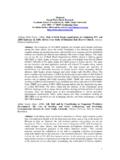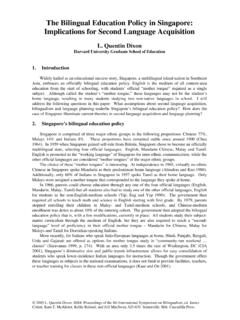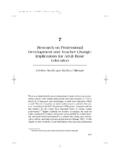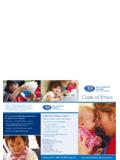Transcription of RESEARCH REPORT 020 - Health and Safety Executive
1 HSE Health & Safety Executive The contribution of individual factors to driving behaviour: implications for managing work -related road Safety Prepared by Entec UK Limited for the Health and Safety Executive and Scottish Executive 2002 RESEARCH REPORT 020 HSE Health & Safety Executive The contribution of individual factors to driving behaviour: implications for managing work -related road Safety Rebecca Lancaster and Rachel Ward Entec UK Limited Doherty Innovation Centre Pentlands Science Park Bush Loan Penicuik Midlothian EH26 0PZ The following REPORT details the findings of a literature review aimed at identifying the individual differences that are associated with driving behaviour and road traffic accidents. Age, gender, ethnicity, education, personality, risk perception, social deviance, previous accident involvement, experience, stress, life events, fatigue and physiology are presented. It is thought that a greater understanding of these issues will aid in the development of more appropriate and effective road Safety policies and procedures and in doing so reduce the munber of work -related road traffic incidents.
2 Consequently the findings are discussed in relation to policy development and Safety culture, recruitment, training, pre and post employment medical screening and management of stress. This REPORT and the work it describes were funded by the Health and Safety Executive (HSE) and the Scottish Executive . Its contents, including any opinions and/or conclusions expressed, are those of the authors alone and do not necessarily reflect HSE or Scottish Executive policy. HSE BOOKS Crown copyright 2002 Applications for reproduction should be made in writing to: Copyright Unit, Her Majesty s Stationery Office, St Clements House, 2-16 Colegate, Norwich NR3 1BQ First published 2002 ISBN 0 7176 2556 7 All rights reserved. No part of this publication may be reproduced, stored in a retrieval system, or transmitted in any form or by any means (electronic, mechanical, photocopying, recording or otherwise) without the prior written permission of the copyright owner.
3 Ii CONTENTS Executive SUMMARY VII 1. INTRODUCTION 1 Background 1 Aims 1 Methods 2 2. SUMMARY OF REVIEW FINDINGS 3 Age 3 Gender 3 Education 4 Personality 4 Aggression 5 Thoroughness in Decision-Making 5 Driving Confidence 5 Attitudes 5 Risk Perception 5 Social Deviance 6 Experience and Previous Motor Vehicle Accidents 6 Stress 6 Life Events / Factors 6 Fatigue 6 Physiology 7 Ethnicity 7 3. implications OF THE FINDINGS FOR OCCUPATIONAL ROAD Safety POLICIES AND PROCEDURES 8 Policy development and Safety Culture 8 Recruitment 8 Training 9 Pre and post employment medical screening 10 Managing stress 10 iii 4.
4 AGE 11 Age and Crash Involvement 11 Age, Social Deviance, and Driving Violations 12 Age and Speeding 14 Age and Alcohol and Drug Usage 15 Age and Seat-Belt Use 16 Age and Gender 17 Age and Ethnicity 17 Age and Risk Perception 17 Age and Personality Factors 18 Age and Aggression / Anger 19 Age and Experience 20 Age and Physiology 23 Age and Driving Skill 23 Age and Fatigue 24 5. GENDER 25 Gender and Crash Involvement 25 Gender and Driving Violations 26 Gender and Speeding 26 Gender and Alcohol and Drug Usage 27 Gender and Seat-Belt Use 27 Gender and Risk Perception 28 Gender and Experience 28 Gender and Driving Confidence 28 Gender and Aggression / Anger 29 Gender and Physiology 29 6. EDUCATION 30 Education and Crash Involvement 30 Education and Speeding 30 Education and Seat-Belt Use 30 Education and Alcohol Usage 30 iv 7.
5 PERSONALITY 32 Personality and Risky Driving 32 Personality and Crash Involvement 33 Personality and Driving Violations 35 Personality and Alcohol and Drug Usage 36 Personality and Seat-Belt Use 38 Personality and Social Deviance 39 Personality and Gender 39 Personality and Risk Perception 40 Personality and Driving Confidence 41 Personality and Fatigue 41 Personality and Experience 42 Personality and Education 42 Personality and Physiology 42 8. AGGRESSION 43 Aggression / Anger and Crash Involvement 43 Aggression / Anger and Alcohol Usage 44 Aggression and Education 44 9. THOROUGHNESS IN DECISION-MAKING, CRASH INVOLVEMENT, AND SPEEDING 45 10. LOW SELF-CONTROL AND SOCIAL DEVIANCE 46 11. DRIVING CONFIDENCE, DRIVING VIOLATIONS, AND CRASH INVOLVEMENT 47 12.
6 ATTITUDES 48 Attitudes, Crash Involvement, and Driving Violations 48 Attitudes towards Drink Driving 48 Attitudes and Fatigue 50 13. RISK PERCEPTION 51 Risk Perception and Alcohol Usage 51 Risk Perception and Experience 51 Risk Perception and Education 51 Risk Perception and Previous Experience of Accidents 51 v Risk Perception and Cultural Differences 51 14. SOCIAL DEVIANCE 53 Social Deviance and Driving Violations 53 Social Deviance and Crash Involvement 54 Driving Violations and Crash Involvement 54 Social Deviance, Crash Involvement, and Driving Violations 55 Social Deviance and Alcohol and Drug Usage 56 Social Deviance and Aggression 56 15. EXPERIENCE AND PREVIOUS MOTOR VEHICLE ACCIDENTS 57 16. STRESS 58 Stress and Crash Involvement 58 Stress and Driving Behaviour 58 Stress and Personality 58 Stress and Aggression / Anger 59 Stress and Fatigue 59 17.
7 LIFE EVENTS / FACTORS AND DRIVING BEHAVIOUR 60 18. FATIGUE 61 Fatigue and Crash Involvement 61 Fatigue and Prolonged Driving 61 Fatigue and Experience 61 Fatigue and Alcohol Usage 61 Fatigue and Physiology 61 19. PHYSIOLOGY 63 Physiology and Crash Involvement 63 Physiology and Experience 63 20. ETHNICITY 64 Ethnicity and Crash Involvement 64 Ethnicity and Driving Violations 64 Ethnicity and Alcohol Usage 64 21. REFERENCES 67 vi Executive SUMMARY An inter-agency work -related Road Safety Task Group was established in May 2000, serviced by the Department for Transport, Local Government and the Regions (DTLR, formerly the Department of the Environment, Transport and the Regions, DETR) and the Health and Safety Executive . This group was established to consider the issue of work -related road Safety and make practical proposals that, when implemented, would reduce the number of work -related road traffic incidents.
8 At the same time, the Scottish Executive wished to establish the extent of work -related road Safety practices and policies in organisations in Scotland, to inform the Scottish Road Safety Campaign and highlight examples of good practice. The HSE and the Scottish Executive therefore jointly commissioned this RESEARCH to achieve these objectives. The Task Group subsequently developed terms of reference (TOR), two of which were to establish (or signal what further work is required to establish) the main causes and related methods of preventing incidents within the specified scope ; and to propose minimum Health and Safety management standards . It is commonly understood that individual differences play a role in safe driving performance. Therefore, regardless of efforts by organisations to manage work -related road Safety , some individuals are more likely to exhibit safe driving behaviour than others.
9 It is argued that a better understanding of these individual differences will allow more appropriate and effective work -related road Safety policies and procedures to be developed, possibly leading to a greater effectiveness in reducing work -related road traffic incidents. This review forms the first of a three-part study commissioned by the HSE and the Scottish Executive as detailed below: Part One: The contribution of individual factors to driving behaviour: implications for managing work -related road Safety . Part Two: Best practice case studies of occupational road Safety policy and procedures. Part Three: The extent to which road Safety is considered a Health and Safety issue in Scottish workplaces. The aims of this review are to: Investigate, by reviewing existing literature, the contribution of individual factors as causes of road traffic incidents. Discuss the implications of the findings for work -related road Safety policies and procedures.
10 The scope of the review was to draw together existing literature rather than conduct a critical review. Due to the extent of the literature, the review concentrates on those studies conducted in the last two decades. However, personality tended to be investigated earlier than other issues such as fatigue, drugs, and alcohol and therefore earlier studies are reported. The review was limited to those individual differences that could be applied in occupational road Safety policies / procedures. Therefore papers on gender after retiring age were excluded, as were papers on income, residency, and peer pressure. Those studies including an investigation of occupation were also omitted, as these studies investigated ranging levels of accident involvement across different types of organisation, rather than individual differences in terms of different roles within an organisation. vii As the literature review was international there are findings associated with cultural / ethnic differences, these findings should be treated with caution as they cannot necessarily be translated to aid our understanding of cultural differences within Great Britain and any implication these may have for occupational road Safety .


















